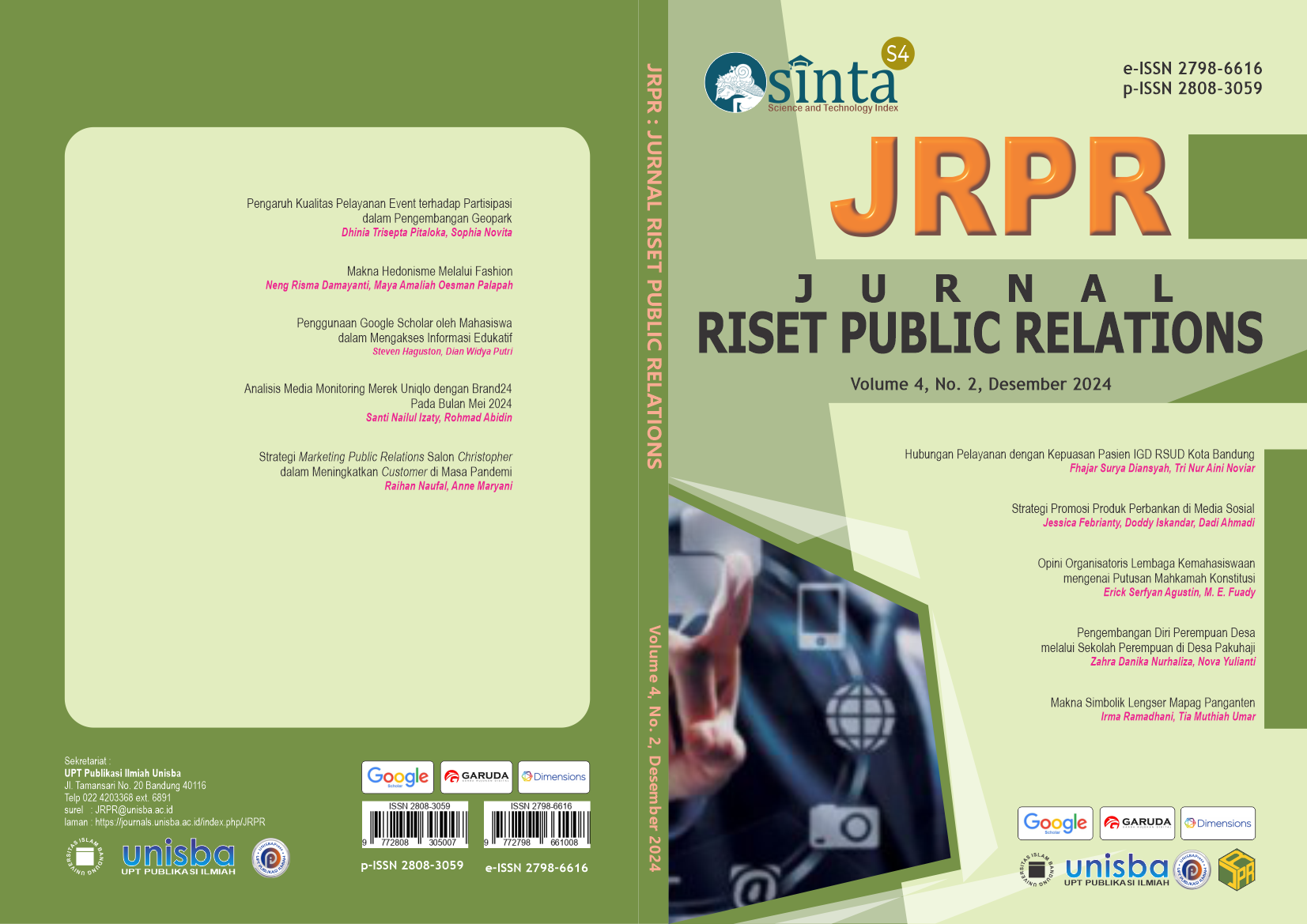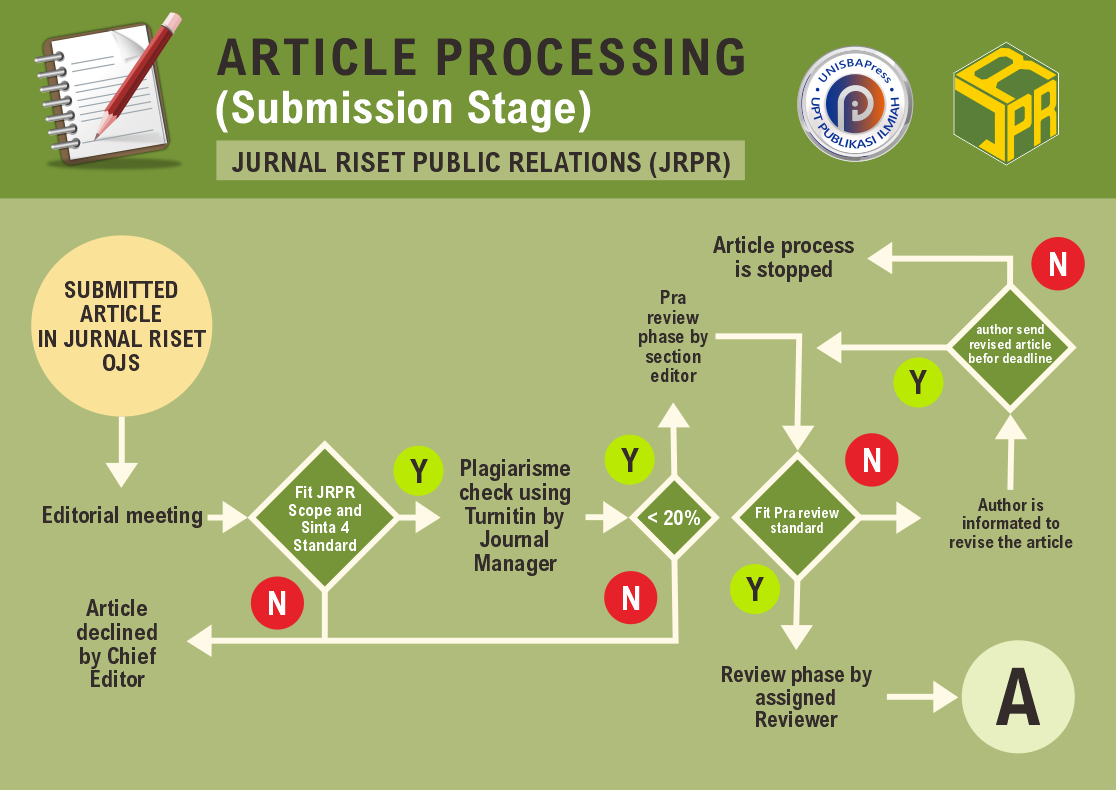Penggunaan Google Scholar oleh Mahasiswa dalam Mengakses Informasi Edukatif
DOI:
https://doi.org/10.29313/jrpr.v4i2.5476Keywords:
Google Scholar, Informasi EdukatifAbstract
Abstrak. Google Scholar banyak menyediakan jurnal-jurnal penelitian atau karya-karya ilmiah, artikel, dan tesis. Kegiatan mahasiswa dalam mengakses Google Scholar ini akan menambah wawasan ilmu pengetahuan apabila digunakan pada saat jam pelajaran sedang berlangsung ataupun sedang belajar dirumah. Metode penelitian yang digunakan adalah metode penelitian kualitatif dengan pendekatan Deskriptif kualitatif. Dalam penelitian ini, peneliti menggunakan paradigma konstruktivis. Dalam penelitian ini, peneliti menggunakan teknik snowball sampling karena memperhatikan pertimbangan tertentu yang kemungkinan akan dihadapai pada saat penelitian. Teknik yang relevan terhadap pengumpulan data terdiri dari Observasi, interfiew, dan dokumentasi. Teknik observasi adalah teknik pengamatan dan pencatatan secara sistemik terhadap gejala yang tampak pada objek penelitian. Dalam pengujian kredibilitas data dibedakan menjadi tiga macam triangulasi sebagai teknik pemeriksaan keabsahan data yang memanfaatkan penggunaan sumber, teknik, dan waktu. Hasil penelitian 5 dari 7 informan yang berhasil diwawancarai mengatakan, manfaat dari penggunaan Google Scholar sangat besar, untuk menambahkan referensi. Pemanfaatan Google Scholar terdapat beberapa hambatan yang dialami oleh mahasiswa dalam mencari informasi edukatif.
Abstract. Google Scholar provides many research journals or scientific works, articles, and theses. This can make it easier for students to find sources of learning, and student activities such as accessing Google Scholar will increase scientific knowledge if used during class hours or while studying at home. The research method used is a qualitative research method with a qualitative descriptive approach. In this study, the researcher uses a constructivist paradigm. In this study, the researcher used the snowball sampling technique because it considers certain considerations that are likely to be faced during the study. Relevant techniques for data collection consist of Observation, Interpreting, and Documentation. The observation technique is a technique of observing and recording systematically the symptoms that appear in the object of study. Testing the credibility of the data is divided into three types of triangulation as a technique for checking the validity of data that utilizes the use of sources, techniques, and time. The results of the study 5 out of 7 informants who were successfully interviewed said, the benefits of using Google Scholar are very large, to add references. With the use of Google Scholar, there are several obstacles experienced by students in finding educational information.
References
Ahmadi, D., Lisnur, W., Nurrahman, A. A., Yanuarti, E., & Basudewa, M. I. (2023). Improving scientific literacy through management of electronic journal using the “open journal system.” AIP Conference Proceedings, 2824(1). https://doi.org/10.1063/5.0158230
Ahmadi, D., Rachmiatie, A., & Nursyawal. (2019). Public participation model for public information disclosure. Jurnal Komunikasi: Malaysian Journal of Communication, 35(4), 305–321. https://doi.org/10.17576/JKMJC-2019-3504-19
Ahmadi, D., Rinawati, R., Fardiah, D., Darmawan, F., Umar, M., & Syam, N. K. (2023). Digital Literacy for Women’s Empowerment: A Solution to Raising Awareness of Countering Hoaxes. https://doi.org/10.29313/mimbar.v39i2.2645`2645
Ahmadi, D., & Sulaeman, A. I. (2009). Sikap Masyarakat terhadap Pemberitaan Bahaya Flu Babi di Media Massa. 25(2), 181–195.
Ahmadi, D., Sulaiman, A. I., Runtiko, A. G., Noegroho, A., Ar Raqi, R. I., Maryani, A., Yuniati, Y., & Yulianita, N. (2023). Marketing Communications for Tourism Development in Ecoethno Leadcamp Site. Studies in Media and Communication, 11(4), 67–77. https://doi.org/10.11114/SMC.V11I4.5909
Al Mega, A. N. P., & Ahmadi, D. (2022). Perencanaan Komunikasi Digital Akun Instagram @ASPAN_Lampung. Bandung Conference Series: Public Relations, 2(2). https://doi.org/10.29313/bcspr.v2i2.3592
Anwar, C. R., Gani, R., Andriani, & Arkam, N. F. (2022). Pendidik, Pelajar dan Orangtua, Ketika Kelas Berada dalam Genggaman. Jurnal Riset Public Relations, 111–116. https://doi.org/10.29313/jrpr.vi.1356
Dewi, A. R., & Ahmadi, D. (2022). Hubungan Terpaan Tweet “Twitter, Please Do Your Magic” dengan Sikap Remaja. Jurnal Riset Public Relations, 6–13. https://doi.org/10.29313/jrpr.vi.639
Faiq Muhammad Fauzan, Firmansyah, & Ahmadi, D. (2024). Bentuk Jurnalisme Warga dalam Pemberitaan di Media Online. Jurnal Riset Jurnalistik Dan Media Digital, 1–8. https://doi.org/10.29313/jrjmd.v4i1.3462
Firnanda Listiyanti, D., & Ahmadi, D. (2022). Hubungaln alntalral Talyalngaln Alkun Tiktok @Liputaln6.Com dengaln Pemenuhaln Kebutuhaln Informalsi. Balndung Conference Series: Public Relaltions, 2(1), 325–332. https://doi.org/https://doi.org/10.29313/bcspr.v2i1.1246
Harahap, N. (2019). Pemanfaatan Google Scholar Dalam Mengakses Informasi Edukatif Dikalangan Mahasiswa Sistem Informasi UINSU. Skripsi.
Indrawan, J., Efriza, & Ilmar, A. (2020). Kehadiran Media Baru (New Media) Dalam Proses Komunikasi Politik. Medium, 8(1), 1–17. https://doi.org/10.25299/medium.2020.vol8(1).4820
Karmila, L., Rachmiatie, A., K, S. S., Fardiah, D., Ahmadi, D., & Muhtadi, A. S. (2024). The role of social media in the political construction of identity: Implications for political dynamics and democracy in Indonesia. Journal of Infrastructure, Policy and Development, 8(14), 9171. https://doi.org/10.24294/jipd9171
Kurnia, S. S., Ahmadi, D., Karsa, S. I., Firmansyah, F., & Iskandar D. (2022). Interpretation of Television Journalists Utilizing Smartphone Technology. Islam, Media and Education in the Digital Era.
Malik, H. K. (2020). Teori Belajar Andragogi Dan Aplikasinya Dalam Pembelajaran. Inovasi, 5(2), 1.
Manzilati, A. (2017). Metodologi Penelitian Kualitatif: Paradigma, Metode, dan Aplikasi. UB Press.
Moleong, L. J. (2009). Metodologi penelitian kualitatif (20th ed.). Remaja Rosdakarya.
Mufidah, T., & Ahmadi, D. (2023). Hubungan antara Iklim Komunikasi Organisasi dengan Motivasi Kerja Karyawan. Journal Perspectives in Communication, 1(1), 19–27. https://journal.sbpublisher.com/index.php/person
Qorib, F., Utami Rezkiawaty Kamil, S., Jumrana, & La Tarifu. (2022). Reshaping Today’s Education with Social Media. Jurnal Riset Public Relations, 105–110. https://doi.org/10.29313/jrpr.vi.1355
Refi Maulana Yusuf, & Dadi Ahmadi. (2022). Kampanye Budaya Beberes di Media Sosial Instagram. Jurnal Riset Jurnalistik Dan Media Digital, 151–158. https://doi.org/10.29313/jrjmd.v2i2.1530
Saefullah. (2020). Pengaruh Kemajuan Teknologi Komunikasi dan Informasi Terhadap Karakter Anak.
Setianingsih, E., Putri, F. W., Rustini, T., & Wahyuningsih, Y. (2023). Pengaruh Adanya Literasi Digital terhadap Menurunya Sikap Sosial di Lingkungan Masyarakat. Journal on Education, 5(2), 3458–3465.
Sugiyono. (2019). Metode Penelitian Kuantitatif, Kualitatif, dan R&D. Alfabeta.















